History of the MG Car Club: Part 11
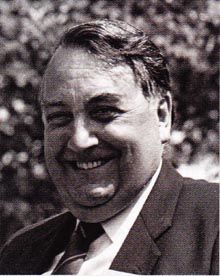
 In writing this chapter in the Club’s history, spanning the years away from Abingdon, I am greatly indebted to the late Martin Brent who, while working for Wilson McComb in the Club Office at MG, was intimately involved with the expulsion of the MG Car Club from the factory; Peter and Christine Tipton who managed the Club from Boston for nearly four years; Peter Browning, so closely involved with our sister club, Austin-Healey at the time and, of course, Bill Wallis, our President whose records and personal recollections span over forty years of the Club’s 70-year life.
In writing this chapter in the Club’s history, spanning the years away from Abingdon, I am greatly indebted to the late Martin Brent who, while working for Wilson McComb in the Club Office at MG, was intimately involved with the expulsion of the MG Car Club from the factory; Peter and Christine Tipton who managed the Club from Boston for nearly four years; Peter Browning, so closely involved with our sister club, Austin-Healey at the time and, of course, Bill Wallis, our President whose records and personal recollections span over forty years of the Club’s 70-year life.
The reverse takeover of BMC by Lord Stokes’ Triumph and Leyland empire signaled the warning that matters BMC would be subjugated and thus it was, when in 1968 the axe fell on the four factory clubs operating out of Abingdon: the Austin-Healey Club, the Mini 7 Club, the Riley Motor Club and the MG Car Club. Safety Fast! was to cease and a new Leyland magazine called High Road was to take its place. Even the now legendary Wilson McComb, the first editor of Safety Fast! and subsequently general secretary of the MG Car Club was powerless to halt the changes.
At this stage feverish discussions were taking place between Martin Brent, Wilson McComb, and John Thornley, the first two named doubtless pondering their future careers, while John Thornley, manager of the MG factory at Abingdon, was far from well, his condition probably not aided by the politics of the new British Leyland. However, John had had earnest discussions with Gordon Cobban, then the chairman of the Club’s South East Centre, a club man through and through, and in the view of Martin Brent and others, the ‘white knight’ at a time when the Club was threatened with extinction.

It was Gordon who perceived the need to enlist the help of Martin, in the absence of Margaret O’Brien (about whom more in a moment), in re-establishing the Club in Abingdon away from the factory. In offices over a bank in the town’s Market Place, assisted by two secretaries, Martin took over the editorship of Safety Fast! at the end of 1968. It was at this time that Margret O’Brien came into prominence. Margret had been a long-serving key administrator dealing with membership for the MG Car Club in its time at the factory. Following a spell in hospital, Margret returned to the MG Car Club in its new offices while Martin Brent (and one of the other secretaries) returned to the factory. Margret ran the office with Teutonic efficiency, she was after all German by birth, and was held in high regard. However as history was to repeat itself years later the Club’s finances could not sustain the cost of the lease and the first Abingdon era, started in 1930, ended 42 years later in 1972. The Club was to be almost another 20 years in exile.
THE GORDON COBBAN ERA
Throughout the period above the bank, Gordon Cobban had made regular visits from his home in Essex, often with his wife Elsie, and it was therefore inevitable that most of the Club’s administration would end up on the other side of London, at Gordon’s home at Ilford. It is probably true to say that it was Gordon’s administrative skills, energy and wholehearted commitment to the Club, often involving paying bills on behalf of the Club out of his own pocket, which maintained the Club structure. The only dark cloud in the closure of Market Place was the fact that archive material, particularly of competition history, which had been rescued from the factory, and stored in the back room above the bank, went missing at this time. Unfortunately, Gordon was not so interested in the tip, which the back room archive store had become! Ultimately, at the end of the lease, most of the remaining material was taken to Syd Beer’s garage at Houghton in Cambridgeshire for safekeeping. Margret O’Brien, however, continued to maintain the Club membership administration until she retired in 1976 when this function was moved to Houghton under Rhubean Warwick.
Thus, throughout most of the 70s, Gordon and Elsie maintained the status quo with membership at modest levels and finances tight. However in August 1978 Gordon, Piers Hubbard and Anthony Littlejohn were entrusted by John Thornley to set up a Club Office.
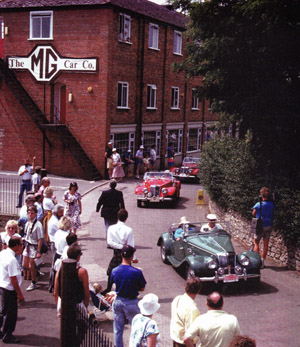
One of the members of this Think Tank was Peter Tipton who in June 1980, aided by his wife Christine, was appointed general secretary in succession to Gordon Cobban on a part-time basis following an advertisement in Safety Fast! of necessity this became full-time in January 1981. With a professional marketing man-and-wife team at the helm, the support of the Lincolnshire Centre and with the lease of premises at 67 Wide Bargate, Boston, the Club began to have some structure once more. The one function that was not maintained at Boston was regalia sales which for two years, 1981-2, were managed by June Wallis from her home at Solihull.
1983-1990 THE LONG HAUL
However by 1983 with Club membership still at a low level and magazine production costs high, the Club’s finances had become perilous. Safety Fast! had been reduced to a bi-monthly publication, complaints from members were rife and South East Centre had presented a charter for the establishment of an elected management committee/board of directors to manage the Club on an ongoing basis, rather than the twice yearly council meetings which were clearly cumbersome and ineffective. For day-to-day management yet another working party was established to take a hard look at all aspects of the Club’s operation. At the same time, in November 1983, the lease of the Boston premises at 67 Wide Bargate was up for renewal. The Club’s solicitor, Rob lnnes-Ker, cautioned against entering into a further five-year lease while so much uncertainty existed. The knock-on effect of this indecision would impact upon the renewal of contract terms with Peter and Christine Tipton. This ultimately led to formal termination of the business relationship at the end of January 1984, although Christine kept matters ticking over for another nine months.
Running parallel with this were several investigations into alternative accommodation. Among the various properties that the then-Chairman Bill Wallis, who had succeeded John Thornley in 1980, and I looked into were a Euro grain store in Banbury, a derelict Morland’s pub in Abingdon town centre, and even the administration office attached to the old MG Car Company A block assembly building. Morland’s Brewery was, as ever, helpful, but discussions with the Austin Morris division of British Leyland elicited the fact that there was space galore at the Austin Morris Training Centre at Studley in Warwickshire. Tempting possibilities of the Club being situated in the beautiful, but as yet unrestored, coach house in the grounds was a motivator but, clearly, temporary accommodation was necessary until the coach house was restored, which in the event it never was.

In the end after considering other properties in the grounds and in the nearby town of Studley, the Club was offered the opportunity to set up a Portakabin, with Anders Clausager, the legendary Archivist of British Motor Heritage (whose home Studley then was) as neighbour; in another Portakabin. Shortly after, a second Portakabin was acquired in which to store regalia.
On December 1 1984, Boston was vacated and the Club’s goods and chattels made their way by van to Studley Castle under the direction of the ever-active Bill Wallis, who had arranged for the address to be PO Box 251, Studley, harking back to the factory telephone and car production start numbers. A new Club administrator, Pat Stout, was appointed and on April 12, 1985, the Club office was officially opened. The Studley temporary Portakabins were to be our home for another four years before the next move, again temporary, which was at least in the right direction, to Radley, some three miles away from the Abingdon factory site. By mid-1987 paid home membership was in excess of 7,800. Workload pressure was increasing for the three staff and the need to determine a long-term home for the Club was clearly becoming more pressing. In August 1987, I scribbled the first plans as to how we might raise £100,000 for an office somewhere….
A month later we received details of a modest residential property at 150 Ock Street, Abingdon, as a result of some research by Geoff Radford (then of the Vintage Register), an estate agent himself, and Chairman Ron Gammons, (who had succeeded Bill Wallis in 1985). After some misgivings the directors of the Club marginally voted in favour of purchase. Thus the position was polarizing, Studley versus Abingdon and Council in October 1987 gave the directors authority to “get on with it” and decide.
However, by complete coincidence, within days of the October Council meeting Austin Rover, as they had become, offered us the lease of a semi-detached house, known as Rookery Cottages, in the grounds at Studley. But on November 25,1987, at a board meeting at Studley the decision was taken to go for Ock Street.
It was after this meeting that trouble started. Vice Chairman, Steve Dear, was strongly of the view that we should take up Austin Rover’s offer of the Studley house in the short term, a view strongly supported by Club President, John Thornley. Steve Dear resigned and John Thornley wrote a scathing letter to the chairman, commenting that when the Club does move back to Abingdon, it is desirable that it should do so with “some sense of style”, rather than “move into a sleazy oasis in this prospering town”. My own position, in a letter to Steve Dear urging him not to resign, was that we could not continue to operate out of Portakabins. “Ock Street is a start and it is Abingdon”. The president’s letter of December 7, 1987, to the chairman sadly saw their relationship at an all-time low, surpassing differences of opinion earlier in the year. Matters came to a head on December 14, 1987, when Vice President Jack Armstrong, on behalf of John Thornley (who was having a cardiac monitor fitted), and past Chairman Bill Wallis attended a special meeting of the directors at St John’s Hotel, Solihull. On the line was John Thornley’s continued presidency if the Club persisted with the Ock Street project. After much reasoned debate four decisions were arrived at: (1) Formal building fund to be launched, details to follow; (2) We would proceed with the temporary lease on the Studley property; (3) That a general secretary would be appointed (club membership was now 8,500) and this was an interdependent requirement; (4) That a property of our own in Studley or Abingdon areas would be sought.
The next day solicitors were instructed to withdraw from the Club’s proposed purchase of Ock Street. One dissenter from this last position was Bill Wallis who felt that the Board had taken an incorrect decision, but that it had had no option in the light of the facts put before it. Upon the outcome of the meeting Steve Dear; who was present, withdrew his resignation, which was happily agreed. However, Steve was still unhappy over a number of issues and continued to press for the Chairman to stand down. In the event it was Steve who left at the end of January 1988. Ironically at the March 19BB board meeting the directors decided that the lease on Rookery Cottages, Studley, could not be taken up because of certain conditions required by Rover Group and the limited two-year planning permission granted by the local council. At that same meeting it was resolved that a new bank account for a Building Fund be set up. At Council on April 16 1988, the Building Appeal was formally launched and well received, with myself as director of the Building Appeal. The battle was on, property prices had been rising while we procrastinated, and time was of the essence. Ron Gammons was re-elected chairman at the October 1988 council for a fourth term, but a year later was succeeded by Will Corry by which time our fifth and penultimate move to Radley had taken place.
During the summer of 1988 fundraising began in earnest. Contributions were received from all over the world, making one feel very privileged to be in the centre of the Club at such an emotional time. In July the chairman and I met with numerous civic dignitaries in the Abingdon area, the Vale of the White Horse District Council, Thames and Chiltern Tourist Board, the local Mayor John Patten, the Curator of Abingdon Museum, the Managing Director of Pavlova Leather Co., Standard Life Assurance Company (who had purchased the factory site) and others.
A proposal was put to the Vale of the White Horse District Council for their support in developing one of a short list of four sites, including, if a greenfield site, a design for a combined museum and administration office. However more realistically, our excitement was increasing as we were becoming aware of the plans of Pavlova Leather who, it should be remembered, had sold the factory site to MG Car Company in 1929 almost 60 years before!
Thus on Tuesday August 30 1988 an extraordinary meeting of the directors was held at the Great Northern Hotel, Kings Cross, London. The purpose was simple. Premises owned by Pavlova Leather Company adjacent to the MG Car Company’s former administration block (now Larkhill House) had come on the market as a development site for eight flats. No. 11, the smallest semi-detached property, was still occupied by Geoff Blanch, a Pavlova employee, and his wife Rene; No. 12 was unoccupied, damp and in generally poor condition, but with considerable potential.
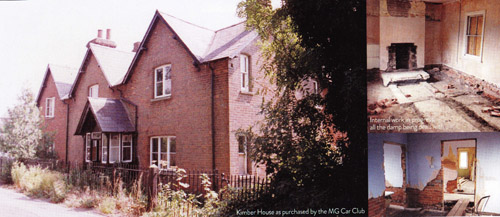
Chairman Ron Gammons had taken advice, in particular from Club member and architect Alan Paine from Lowestoft. Alan subsequently had to commute between the East Coast and Abingdon many times before the day was out. After survey, Alan was of the view that £175,000 was a reasonable offer for the entire site. The chairman and I had also sought the opinion of the President, iohn Thornley, who told us to “go for it” on the basis that the site value for flat development provided a very good fall back position if we failed to achieve our goal, since the restoration costs were estimated at another £75,000!
At that Kings Cross meeting the board considered, and rejected, the three other possible sites in Abingdon and the way forward was clear. The Chairman proposed, and I seconded, that we proceed with our offer and seek planning approval for change of use. The board was unanimously in favour. Two further board meetings took place in September; the second of which, on 27th, was specially convened to discuss an unexpected letter received from the president requiring Ron Gammon’s resignation following a number of differences of opinion. Vice President Bill Wallis was present. After a debate lasting over an hour; the directors felt that Ron, in the interests of Club harmony, should not stand for re-election the following month. At that same meeting, I reported that the Building Fund had exceeded £30,000, and the chairman reported that an “elder statesman” of the Club was, in broad terms, amenable to the granting of a six-figure loan for the fund. An eventful meeting!
In the event, Ron was re-elected for one last year which was considered to be in the best interests of the Club and, importantly, the Building Appeal at that time, before Will Corry succeeded him at the November 1989 AGM. Fund raising continued unabated at national and local level. The lottery raised £12,000 in 19BB (with a winning prize to the Monaco Grand Prix). The first reprint of a Gordon Crosby painting owned by John Thornley of the MG 18/100 Tigress at Brooklands in 1930 was launched that year with copies signed by John Thornley at £50, unsigned £25, and this was followed by Bryan De Grineau’s painting of the MG K3 driven by Count Johnny Lurani in the 1933 Mille Miglia. Count Johnny Lurani and his wife were guests of honour at Silverstone on May 27-28, 1989 and, again, freshly signed prints were eagerly snapped up at £50.
The 1989 lottery, which raised another £7,000, featured a flight on Concorde for two people as first prize. Three auctions of automobilia and parts were held at Silverstone. A run of 750 Royal Doulton plates showing M-types leaving the factory down Cemetery Road was commissioned, selling at £28 each. We had loads of wall clocks from Germany, limited edition commemorative watches from Switzerland and numerous other items from tee shirts to Christmas cards. But equally important was the money collected at Natters and local events in Building Appeal Buckets, the initiative of Dennis (The Bucket) Ogborn, or sponsored events, too many to recall, not only around the United Kingdom, but throughout the world. To mention individuals by name would be invidious and incomplete, but amounts of a few pounds to several hundred steadily flowed into Club Office throughout the campaign.
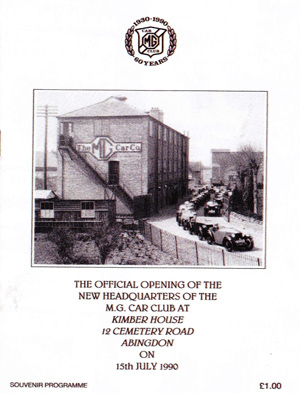
While all this excitement over the purchase was going on in the summer of 1989, the Club was fortunate enough to take a lease on office premises at J.C. Curtis & Son, Haulage Contractors and Quarry Operators, at Radley. Not only was the Club psychologically and physically now already back in Abingdon, it also meant we were on the spot while building works continued under Alan Paine, assisted by Michael Cannon, the deputy Club administrator in Club office. Thus Phase II, The Diamond Jubilee Building Appeal, was launched with a new brochure, this time depicting a real building which the Club owned. Site clearance began on November 13 1989 and a number of members kindly donated their time or provided building materials free, or at cost, to help the project along. As the one-year lease at Radley was up in June 1990, the target date for our staff to move in to Cemetery Road was set!
Funds continued to come in during 1990 although slower than before. Building work was not held up and the great opening day came on July 15, 1990, when Lord Montagu of Beaulieu formally opened the Club offices in front of a large crowd of Club members from around the world. They witnessed a very emotional occasion. By the end of 1990, with another successful raffle yielding £7,000, the deficit to clear the refurbishment costs was down to £14,500. In 1991, after a third successful Silverstone, the deficit was a mere £3,082 and the battle was effectively won.

Income continued to trickle in right through the 1990s as the balance of prints and plates was finally exhausted and members’ standing orders ran their course.
Finally, tribute must be given to the team that supported me throughout the campaign: Jon Moore (who ably organised the annual lottery), Phil Jennings, Dennis Ogborn, Christine Poxon, Peter Mace, Simon Farthorpe, our Silverstone Auctioneers, Glynn Guisti and Geoff Radford, and Club office staff led by Club Administrator Marilyn Moule and later Lyn Jeffrey plus others too numerous to mention in Centres and Registers around the country and overseas.
With the support of Club members and well-wishers worldwide, the campaign raised a staggering figure of just under £150,000.
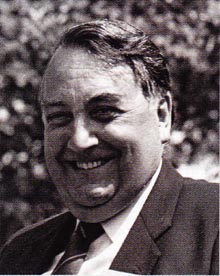 Peter Best was brought up in Hendon, north London, but later moved to Hove in Sussex when he joined the Merchant Navy and later joined a shipping line. He joined the Ford Motor Company in 1961 working in marketing and sales traveling the world extensively. He later moved to Volvo where insurance was part of his responsibilities which led to the formation of his insurance company founded with his wife Marian in 1985. Today Peter Best Insurance Services is a strong specialist insurance broker with particular interest in classic cars and including MG. Peter joined the MGCC in 1974 and was Chairman from 2005-2007 playing a major role in the Kimber House Appeal Fund.
Peter Best was brought up in Hendon, north London, but later moved to Hove in Sussex when he joined the Merchant Navy and later joined a shipping line. He joined the Ford Motor Company in 1961 working in marketing and sales traveling the world extensively. He later moved to Volvo where insurance was part of his responsibilities which led to the formation of his insurance company founded with his wife Marian in 1985. Today Peter Best Insurance Services is a strong specialist insurance broker with particular interest in classic cars and including MG. Peter joined the MGCC in 1974 and was Chairman from 2005-2007 playing a major role in the Kimber House Appeal Fund.
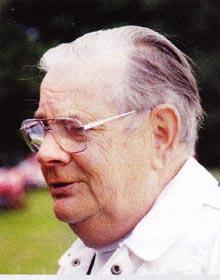 Syd Beer was an analytical chemist by profession and his love of motor cars started when he enjoyed time in his father’s garage and developed a passion for classic cars. This led him to start a collection of MGs at his village garage in Houghton near St Ives in Cambridgeshire. Amongst the famous cars he owned was the ex Kaye Don K3 single seater, ex Harvey Nobile Q Type and ex Norman Blck NE. Syd formed a close friendship with John Thornley which led to his acquiring the pair of Jacobs Midgets and the most successful ex works MGB. When the Club found itself without a home in the British Leyland era, Syd offered premises at Houghton for two years.
Syd Beer was an analytical chemist by profession and his love of motor cars started when he enjoyed time in his father’s garage and developed a passion for classic cars. This led him to start a collection of MGs at his village garage in Houghton near St Ives in Cambridgeshire. Amongst the famous cars he owned was the ex Kaye Don K3 single seater, ex Harvey Nobile Q Type and ex Norman Blck NE. Syd formed a close friendship with John Thornley which led to his acquiring the pair of Jacobs Midgets and the most successful ex works MGB. When the Club found itself without a home in the British Leyland era, Syd offered premises at Houghton for two years.
NAMGAR would like to thank Andy Knott, Editor, Safety Fast! for his kind permission to reproduce these articles.

